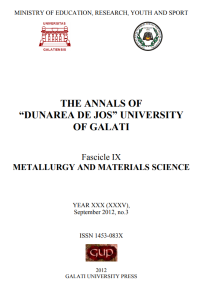Research Regarding the Possibility of Obtaining Nitinol by Powder Metallurgy
Abstract
In the paper the obtaining of nitinol by pressing and sintering of a mixture of nickel and titanium powders is presented. The fabrication of NiTi alloys by powder metallurgy allows avoiding the usual problems related to classical casting obtaining methods (problems related to defects caused by segregation or excessive growth of the grains), it also assures an exact control of the chemical composition and offers the possibility of manufacturing a variety of components very close to their final shape.
Although the advantages of manufacturing products by powder metallurgy are certain, the first research presented in this paper in the case of nickel and titanium powders have showed some unwanted aspects related to powder metallurgy processing which are yet to be resolved, that is, the high oxide content, the high content of secondary phases, also the difficulty of obtaining dense materials. The main conclusion is that it is imperative to do the sintering in a protecting system (if possible in vacuum), because of the high content of oxygen observed in the measured sintered products.
Downloads
References
[2]. George B. Kauffman – California State University, Fresno Fresno, CA 93740-0070 ISAAC MAYO College of Veterinary Medicine Cornell University Ithaca, NY 14853-6401, The Story of Nitinol: The Serendipitous Discovery of the Memory Metal and Its Applications, The Chemical Educator 3/Vol. 2, No. 2, (1996) SPRINGER-VERLAG NEW YORK, INC.
[3]. Frémond, M. and Miyazaki, S. – Shape Memory Alloys. CISM Courses and Lectures, Springer, Wien-New York, (1996), ISBN 3-211- 82804-4.
[4]. C.M. Craciunescu – Shape memory alloys micro and nanoengineering, Ed. Politehnica, Timisoara, Romania, (2005).
[5]. F. Neves, F.M. Braz Fernandes, I. Martins, J.B. Correia, M. Oliveira, E. Gaffet, T.-Y. Wang, M.Lattemann, J. Suffner and H. Hahn - Nonconventional production technologies for NiTi shape memory Alloys - ESOMAT 2009, 05023 (2009), DOI:10.1051/esomat/200905023.
[6] Y. Sutou a, T. Omoria, J.J. Wang b, R. Kainumaa, K. Ishida – Characteristics of Cu-Al-Mn- based shape memory alloys and their applications, Materials Scinece and Engineering A 378 (2004) 278-282.
[7]. F. Neves, I. Martins, J.B. Correia, M. Oliveira, E. Gaffet - Intermetallics 15, 1623 (2007).
[8]. F. Neves, I. Martins, J.B. Correia, M. Oliveira, E. Gaffet, Intermetallics 16, 889, (2008).
[9]. Wayman, C.M., Deformation - Mechanisms and other characteristics of shape memory alloys, Shape Mem. Eff. All., (Perkins, J., ed.), Plenum Press, (1975), 1-27.



